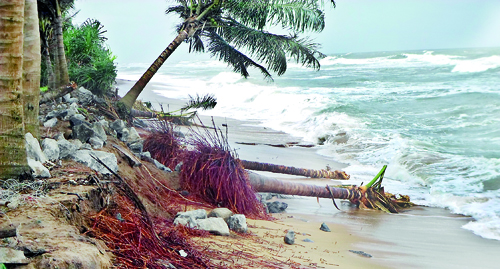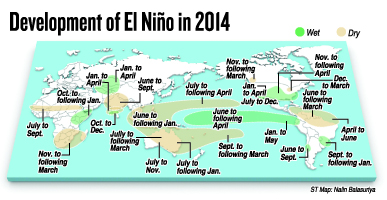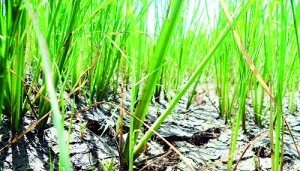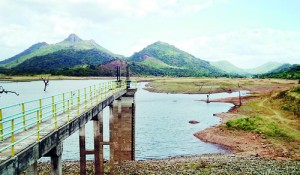News
Get set for a wild weather ride, say climatologists
More than 2,000 houses and hundreds of acres of crops were damaged as gale force winds swept through the Central, Uva and Sabaragamuwa provinces this week amidst warnings from weather experts to expect extreme erratic weather patterns in the coming months.

Rough seas in Kalutara. Pic by Sarath Siriwardene
They warn that the extreme weather patterns could be due to the El Nino effect with a change in the climate of the Pacific Ocean causing the region around the equator to suffer strong winds, high humidity, heatwaves, weak monsoons and drought.
Last week’s wild weather hit Kandy, Nuwara Eliya, Matale, Badulla, Ratnapura, Kegalle, Hambantota and Trincomalee districts, affecting more than 7,500 people.
In the Nuwara Eliya district, about 400 houses were damaged by strong winds blowing across the Walapane, Nuwara Eliya, Hanguranketha and Kotmale areas. Some 53 families were forced to find shelter in temples at Harasbadda and Senerathpura and in the Ratmalwatte kovil.
In Kandy, 23 houses in Deltota, Panvila and Ududumbara were damaged. Close to 20 houses were damaged in the Matale district, especially in Dambulla.
Badulla district was the worst affected by unexpected strong winds with more than 600 houses damaged in Haldumulla, Uva-

Coconut trees caught up in strong winds in Puttalam. Pic by Hiran Priyankara
Paranagama , Welimada and Bandarawela. In Welimada, 320 houses were damaged, with roofs blown away and trees falling on houses. One person was killed and eight others injured.
In Ratnapura, 241 people were evacuated after strong winds hit the Imbulpe area. The University of Sabaragamuwa, a victim of last week’s gale force winds, is to reopen tomorrow following damage to university hostels and an electricity breakdown.
Director (Forecasting) of the Meteorology Department, S.R. Jayasekare said recent monsoons, starting from last November, have been weak and the current south-west monsoon, that had been expected to bring heavy rains had not done so.
He said the coming El Niño could cause erratic weather changes with a warming trend. One warning sign was the prevailing dry spell bringing drought conditions that are severely affecting the agriculture industry.
“The last El Niño condition caused severe drought in 1997-98 to countries like Indonesia while Sri Lanka experienced both a dry spell and then strong thunderstorms. Weak monsoons and heat waves can be signs of the establishing El Niño and this could have an impact next year too,” he said.
Mr. Jayasekare said that because El Niño weather changes were unpredictable there was room for hope that there could be heavy rainfall from October to December.
El Nino is an unusual warming of ocean waters in the tropical Pacific but these warm currents have an impact on the weather worldwide with weaker monsoons in countries such as India and Sri Lanka, droughts and forest fires in Indonesia and northern parts of Australia, and heavy rainfall in South America.
Disaster Management Ministry officials asked the public to take preventive measures to avoid harm.
“Although it is usually windy during August and ideal for kite flying, the recent winds are more of a destructive nature. Those who live in landslide-prone, flood-prone areas should be ready for any weather extremes in the coming months.
“Similarly, we advise the public to make sure the roofs of their houses are strongly secured. Any large trees in front of houses that could cause damage if thet fall should be removed,” said the spokesman for the Disaster Management Ministry, Sarath Lal Kumara.
He said arrangements are being made to compensate those affected by strong winds through the District Secretaries (Government Agents) with about Rs. 100,000 for a completely damaged house.
| Farmers face harsh future
With meteorological officials warning of dry spells in the coming months especially in the key agricultural districts of Anuradhapura, Polonnaruwa, Moneragala, Mannar, Puttalam, Vavuniya and Kurunegala, farmers are struggling to face an uncertain, harsh future.  paddy fields in Menikdeniya The absence of rainfall from last year’s north-east monsoon from November 2013 to January this year and the first inter-monsoon in March and April have caused reservoirs, tanks and rivers to dry up and crop levels to fall. Lakshman Premanath, Provincial Director for Agriculture in the North Central province said Anuradhapura and Polonnaruwa districts are severely affected by the drought that continued throughout the year. “Paddy cultivation was badly hit and out of the 33,127 hectares only 14,861 ha were in production this Yala season. Though discussions are underway, farmers have not yet been compensated. If this situation continues Anuradhapura will face a drinking water problem as well,” he said. He said attempts to promote cash crops such as moong and soya beans had also failed  The dried up Wemedilla wewa in Dambulla Pix by Kanchna Kumara Ariyadasa due to extreme heat conditions and paddy farmers having doubts about switching to cash crops. “We are attempting to promote onion cultivation among farmers now,”he said. Irrigation Department chief Badra Kamaladasa told the Sunday Times that water levels in reservoirs had fallen to an alarming level and that there was a severe shortage of water for cultivation. “The Irrigation Department is presently building agro-wells in areas such as Padaviya and Huruluwewa for cultivation. It is necessary to save water for domestic consumption as well. Therefore water is released only once in five days,” she said. Ms. Kamaladasa said the Yala season experienced heavy losses and that the only hope for the Maha season is the North East monsoon starting in October.
Strawberry crush Last week’s strong winds destroyed eight polytunnels that housed strawberry and flower plants in Walapane and Kotmale, causing almost Rs. 1 million worth of damage, the District Secretary of Nuwara Eliya D.P.G. Kumarasiri said. He also said prepared food and dry rations were being distributed to people left homeless by the weather. Officials decided on Friday to provide 4,800 new iron roofs to families in low-income settlements as most of the roofs were damaged. Mr. Kumarasiri also said there was heavy damage to roofs of line houses belonging to the Janatha Estates Development Board that date back to almost a century. “We are hoping to inform the Plantations Ministry regarding repairs and maintainance of these houses,” he said. |

